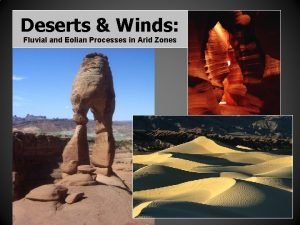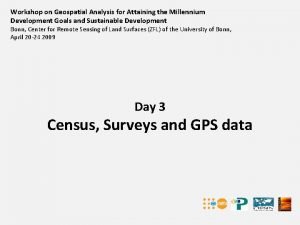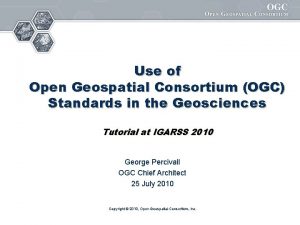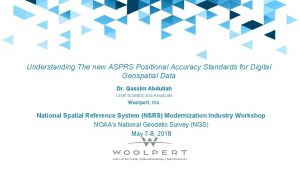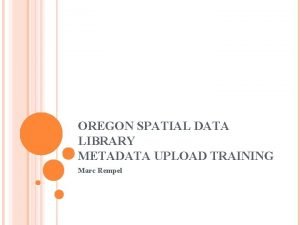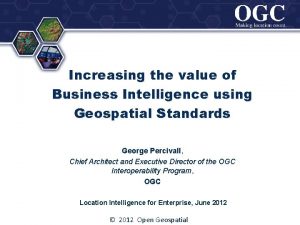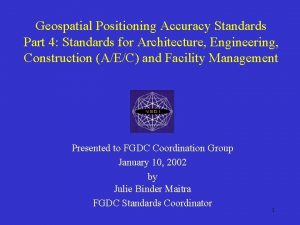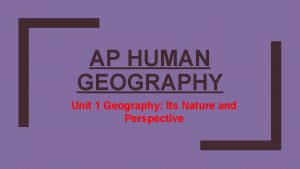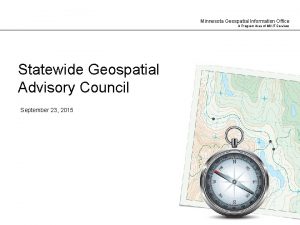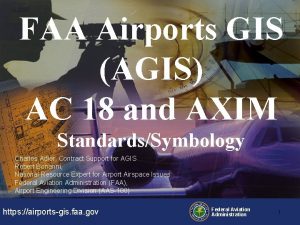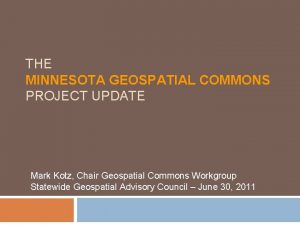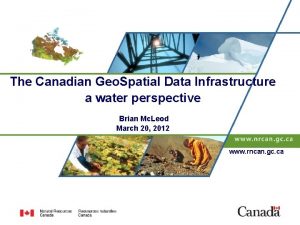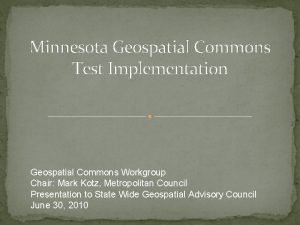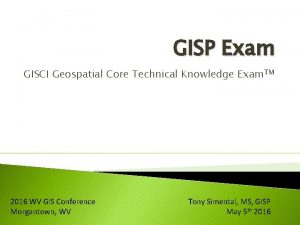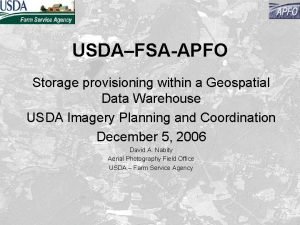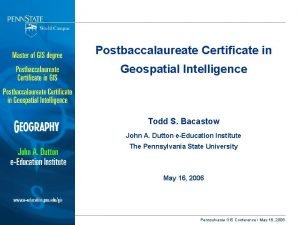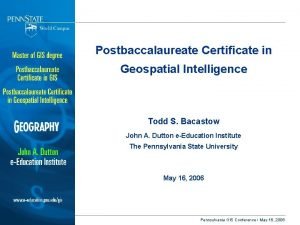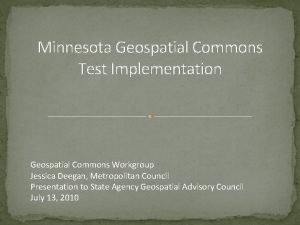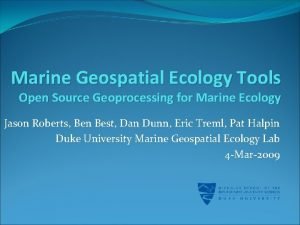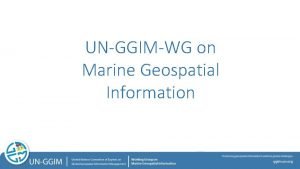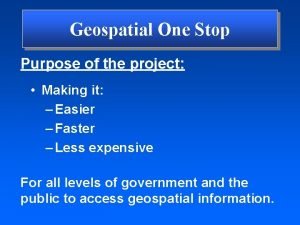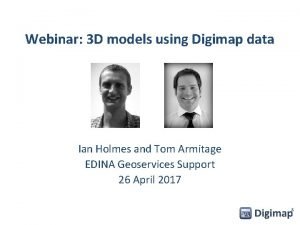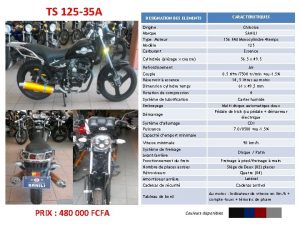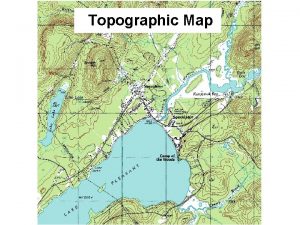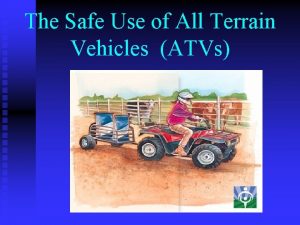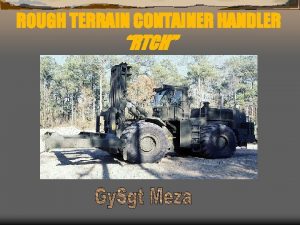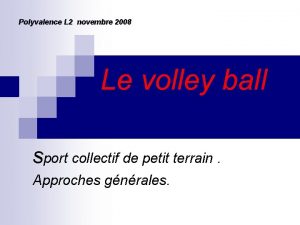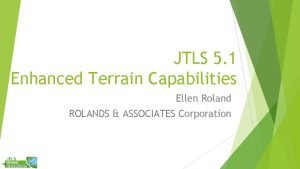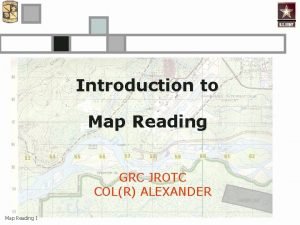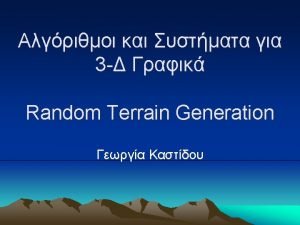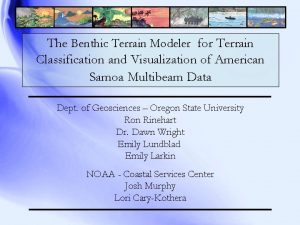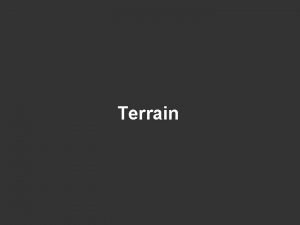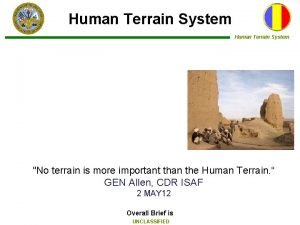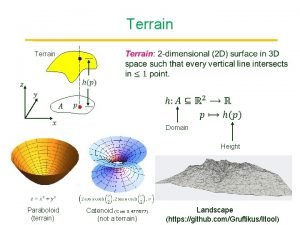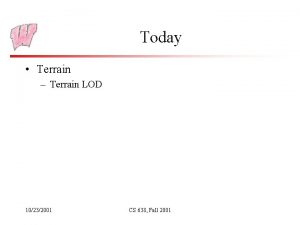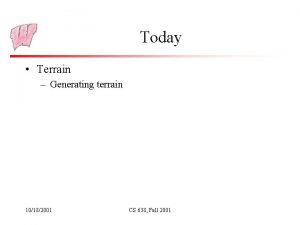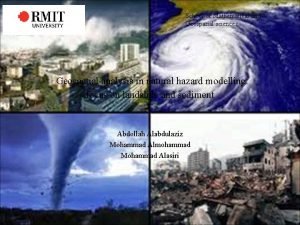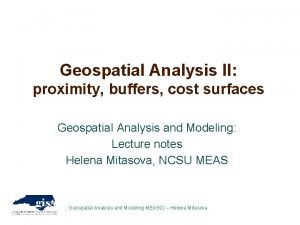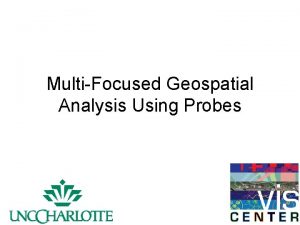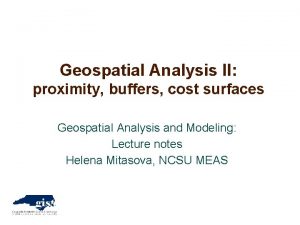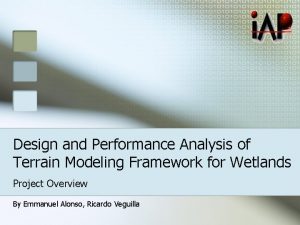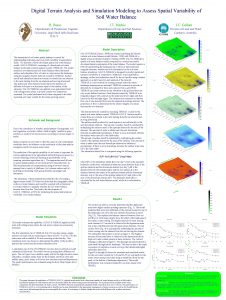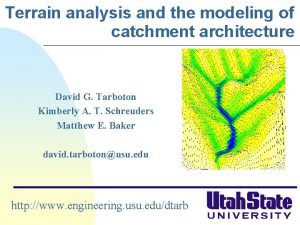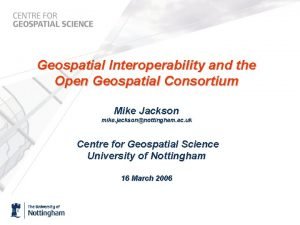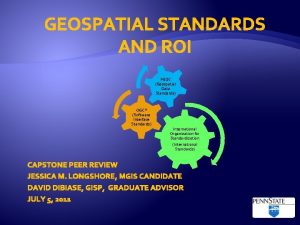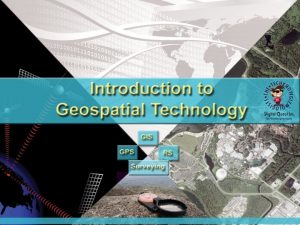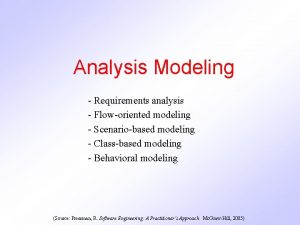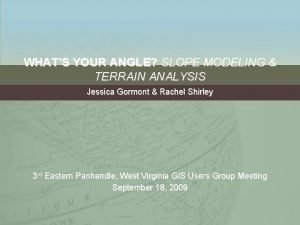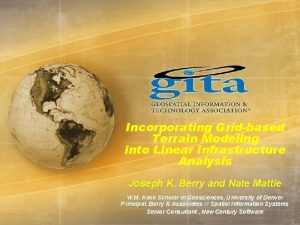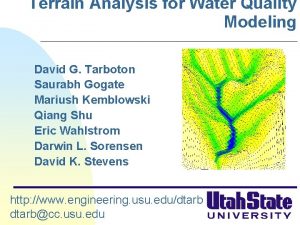Geomorphometry I Terrain modeling Geospatial Analysis and Modeling














































- Slides: 46

Geomorphometry I: Terrain modeling Geospatial Analysis and Modeling: Lecture notes Helena Mitasova, NCSU MEAS Geospatial Analysis and Modeling - NCSU MEAS – Helena Mitasova

Outline • • Definitions 3 D mapping technologies mathematical and digital terrain models point clouds, multiple return data triangular irregular networks regular grid (raster) isolines and meshes point cloud analysis and binning Geospatial Analysis and Modeling - NCSU MEAS – Helena Mitasova

Definitions • Land (bare earth) surface: interface between solid Earth and atmosphere/anthroposphere/biosphere • Terrain surface : interface between Earth with water, vegetation, structures and atmosphere • Bathymetry: interface between solid Earth surface and hydrosphere (bottom surface of lakes, rivers and ocean) • Seamless topobathy: continuous solid earth surface Geospatial Analysis and Modeling - NCSU MEAS – Helena Mitasova

Bare Earth and Terrain surface Bare ground surface Terrain surface: bare ground + vegetation and structures Geospatial Analysis and Modeling - NCSU MEAS – Helena Mitasova

Bathymetry: sand disposal Nearshore bathymetry Geospatial Analysis and Modeling - NCSU MEAS – Helena Mitasova

Seamless topobathy Geospatial Analysis and Modeling - NCSU MEAS – Helena Mitasova

Mathematical terrain models Mathematical representations of bare Earth surface: • bivariate function (for each x, y there is only one value of z): z = f(x, y) Geospatial Analysis and Modeling - NCSU MEAS – Helena Mitasova

Mathematical terrain models Mathematical representations of bare surface: • bivariate function: z=f(x, y) • non-stationary signal consisting of multiscale components z(x, y)=S(x, y)+Dj-1(x, y). . . D 1(x, y) where S(x, y) is the smoothest component, Di (x, y) are progressively more detailed components • deterministic component zd +random spatially correlated error + noise z(x, y)=zd(x, y)+e'(x, y)+e”(x, y) Geospatial Analysis and Modeling - NCSU MEAS – Helena Mitasova

Multiscale terrain components Terrain profiles at different level of detail Sand dune vegetated area z(x, y)=S(x, y)+Dj(x, y) Geospatial Analysis and Modeling - NCSU MEAS – Helena Mitasova

Mathematical terrain models Is the bivariate function representation general enough? General 3 D surface defined using parametric representation: x=f(u, v), y=g(u, v), z=h(u, v, ), Supported by K 3 DSurf, CAD GIS: 3 D vector model Geospatial Analysis and Modeling - NCSU MEAS – Helena Mitasova

Terrain mapping technologies Continuous surface measured at discrete points • Human selected points (GPS, total station, photogrammetry) • Automated point sampling (lidar, RTK GPS, sonar) Land terrain mapping • • Stereophotogrammetry: mass points and breaklines IFSARE: raster, Lidar: point cloud On-ground 3 d laser scanner: point cloud RTK GPS: point profiles Bathymetry mapping single and multiple beam sonar Geospatial Analysis and Modeling - NCSU MEAS – Helena Mitasova

Mapping Technology: land RTKGPS LIDAR: Light Detection and Ranging USGS/NOAA/NASA ATM-II, EAARL On-ground laser scanner Haiti LIDAR: http: //www. wired. com/wiredscience/2010/01/haiti-3 d-flyover/

Mapping technology: bathymetry Nearshore Bathymetry: single beam sonar Bathymetry: multibeam sonar

Elevation data: point distribution

Elevation data: accuracy

substantially improved representation of structures but much larger data sets 1 m res. DEM, computed by RST, 1998 lidar data 2004 lidar, 0. 5 m resolution DEM binned and computed by RST (smoothes out the noise and fills in the gaps)

Ground based laser scanner data Point cloud and image 0. 1 m res. DEM and rgb image

Elevation data: beach and bathymetry Hatteras Island before And after Isabel 2003 Bathy-topo survey of the breach: single beam sonar RTK GPS semiautomated point selection

Post Isabel Hatteras Breach

Digital terrain representations • Point clouds – measured data • TIN – Triangular Irregular Network • Regular grid (raster) • Contours - elevation isolines • Mesh Geospatial Analysis and Modeling - NCSU MEAS – Helena Mitasova

Point clouds • Set of (x, y, z, r, i, . . . ) measured points reflected from Earth surface or objects on or above it, where x, y, z are georeferenced coordinates, r is the return number and i is intensity, r: g: b may be also measured • Provided in – ASCII (x, y, z, . . . ) format – binary LAS format (header, record info, x, y, z, i, scan dir, edge of flight line, classification, etc. ), industry lidar data exchange format Geospatial Analysis and Modeling - NCSU MEAS – Helena Mitasova

Point clouds Processing: – – filtering outliers (birds etc. ) bare earth point extraction canopy extraction structures and power lines extraction Public data sources (http in Summary slide): CLICK: raw point clouds usually in LAS format LDART: costal point clouds with on-fly binning NC Floodplain Mapping: bare Earth: points, 20 ft DEM and 50 ft DEM with carved channels Geospatial Analysis and Modeling - NCSU MEAS – Helena Mitasova

Point clouds Multiple return point cloud data from 2001 NC Flood mapping program – yellow is first return Image from LIDAR primer, Geospatial solutions 2002 Geospatial Analysis and Modeling - NCSU MEAS – Helena Mitasova

TIN • Triangular Irregular Network: constructed from the measured points by triangulation (before computer age this technique was used for manual interpolation of contours from surveyed points) • Delaunay Triangulation: maximizes the smallest angle of the triangles to avoid skinny triangles • Constrained Delaunay Triangulation – includes predefined edges that cannot be flipped • TIN is a vector data model representation, that usually preserves the original data points Geospatial Analysis and Modeling - NCSU MEAS – Helena Mitasova

TIN Given points Delaunay TIN Geospatial Analysis and Modeling - NCSU MEAS – Helena Mitasova

TIN Delaunay TIN from random points and contour points Geospatial Analysis and Modeling - NCSU MEAS – Helena Mitasova

TIN properties • requires pre-defined breaklines for man-made features, valleys, faults, etc. • density of TIN is adjusted to surface complexity • additional points may need to be interpolated to create smooth surface When to use TIN: • engineering applications, • manual modification of model is desired(design), • complex faults need to be represented, • multiscale representation for visualization Geospatial Analysis and Modeling - NCSU MEAS – Helena Mitasova

TIN issues • discontinuity in first derivative along edges: artificial triangular structures on the surface • dams can be created across valleys if stream is not defined as a breakline • if input are points on contours: flats on the top of hills or ridges if no peaks are defined Image by TERRASTREAM Dept. of Computer Science, Duke University Geospatial Analysis and Modeling - NCSU MEAS – Helena Mitasova

Regular grid - raster Two interpretations: • elevation assigned to a grid point – center of the grid cell • elevation assigned to the pixel area Derived from measured points by gridding: • at least one point for each grid cell – binning, • if some grid cells do not include points – spatial interpolation or approximation Geospatial Analysis and Modeling - NCSU MEAS – Helena Mitasova

Regular grid - raster Given Points Regular Grid Geospatial Analysis and Modeling - NCSU MEAS – Helena Mitasova

Regular grid: properties • simple data structure and algorithms • easy to combine with imagery • uniform resolution - potential for undersampling and oversampling • representation of faults and sharp breaklines requires very high resolution Geospatial Analysis and Modeling - NCSU MEAS – Helena Mitasova

Regular grid -public data Most available elevation data are distributed as raster data: • USGS Seamless Data Distribution – NED 1/9 (3 m), 1/3 (10 m), 1 arc/sec (30 m), • SRTM-V 4: USA 30 m, World 90 m • GDEM 15 -30 m: global, relative height, derived from ASTER satellite stereo bands • NCFlood mapping web site: 20 ft and 50 ft DEM • CRM for bathymetry: 90 m • Seamless Topobathy: Tsunami data and RENCI NC data 10 m Geospatial Analysis and Modeling - NCSU MEAS – Helena Mitasova

Isolines, contours • traditional approach for representation of elevation, drawn by hand from measured mass points by interpolating along triangle edges • automated procedures: from TIN or grid, • not very suitable for highly detailed, noisy data such as lidar • needed when the surface has simple geometry • selecting contour interval: depends on slope and resolution Geospatial Analysis and Modeling - NCSU MEAS – Helena Mitasova

Isolines, contours Contours from lidar Geospatial Analysis and Modeling - NCSU MEAS – Helena Mitasova

Point cloud analysis: binning Binning: fast method for analyzing point clouds and generating DEMs using per-cell processing: • at least one point for each grid cell • analysis: number of points per cell, range, stddv • Methods for DEM: mean, min, max, nearest • sufficient for many applications • no need to import the points, on-fly raster generation • may be noisy, include no-data spots Geospatial Analysis and Modeling - NCSU MEAS – Helena Mitasova

Point cloud analysis: input Multiple return point cloud all returns first return Geospatial Analysis and Modeling - NCSU MEAS – Helena Mitasova

Point cloud analysis: input Bare earth and multiple return point cloud all returns bare earth Geospatial Analysis and Modeling - NCSU MEAS – Helena Mitasova

Point density Number of bare earth points in each 2 m and 6 m resolution cell Number of points from ground based scan in each 40 cm grid cell Geospatial Analysis and Modeling - NCSU MEAS – Helena Mitasova

Points per-cell elevation range Range of bare earth elevations zmax-zmin in each cell at 6 m resolution Geospatial Analysis and Modeling - NCSU MEAS – Helena Mitasova

Points to grid: per-cell mean Mean bare earth elevation for each 6 m cell Not enough bare earth points : interpolation is needed Geospatial Analysis and Modeling - NCSU MEAS – Helena Mitasova

Point density Number of points in each 2 m resolution cell for 2001 and 2004 lidar survey near Oregon Inlet 1 7 14 21 28 35 Geospatial Analysis and Modeling - NCSU MEAS – Helena Mitasova

Points per-cell elevation range Range of elevations zmax-zmin in each cell at 0. 3, 1. , 5. and 10 m resolutions – 2004 lidar near Oregon Inlet 5 m 4 3 2 1 0 Geospatial Analysis and Modeling - NCSU MEAS – Helena Mitasova

Points to grid - binning Jockey's Ridge 1999, unfiltered single return lidar point cloud: 1 m grid cell binning using maximum elevation Result has many NULL cells – what to do? Geospatial Analysis and Modeling - NCSU MEAS – Helena Mitasova

Points to grid - binning 3 m grid cell binning: mean Geospatial Analysis and Modeling - NCSU MEAS – Helena Mitasova

Points to grid - interpolation 1 m DEM interpolated by splines – see next lectures Geospatial Analysis and Modeling - NCSU MEAS – Helena Mitasova

Summary and references • Mathematical and digital terrain representation – Hegl CH. 2 Chang Ch. X, Neteler Ch. 5, 6 • Point clouds and TIN – Hegl, Chang Ch. X, Neteler Ch. 6. • Regular grids – Hegl, Neteler Ch. 7, others • Isolines and meshes – Hegl, Neteler Ch 5 Links to elevation data distribution sites see http: //skagit. meas. ncsu. edu/~helena/classwork/hon 297 webgis. html LIDAR: http: //www. forestry. gov. uk/forestry/INFD-6 RVC 9 J http: //www. geospatial-solutions. com/geospatialsolutions/article. Detail. jsp? id=10275 Geospatial Analysis and Modeling - NCSU MEAS – Helena Mitasova
 Helen erickson biography
Helen erickson biography Relational modeling vs dimensional modeling
Relational modeling vs dimensional modeling Mesa and scarp terrain
Mesa and scarp terrain A section of the nile river with rapids and rocky terrain
A section of the nile river with rapids and rocky terrain Millennium geospatial
Millennium geospatial Open geospatial consortium standards
Open geospatial consortium standards Asprs positional accuracy standards
Asprs positional accuracy standards Oregon spatial data library
Oregon spatial data library Geo business intelligence
Geo business intelligence Brabant water hoofdkantoor
Brabant water hoofdkantoor Geospatial positioning
Geospatial positioning Geospatial data definition ap human geography
Geospatial data definition ap human geography Geospatial commons
Geospatial commons Minnesota geospatial program
Minnesota geospatial program Faa nasr
Faa nasr Bcc geospatial center of the cuny crest institute
Bcc geospatial center of the cuny crest institute Mit geospatial data center
Mit geospatial data center Mn geospatial commons
Mn geospatial commons Canadian geospatial data infrastructure
Canadian geospatial data infrastructure Minnesota geospatial commons
Minnesota geospatial commons Gisci geospatial core technical knowledge exam
Gisci geospatial core technical knowledge exam Topographic map definition ap human geography
Topographic map definition ap human geography Gdw data warehouse
Gdw data warehouse Geospatial intelligence certificate online
Geospatial intelligence certificate online Geospatial
Geospatial Geospatial intelligence certificate
Geospatial intelligence certificate Minnesota geospatial commons
Minnesota geospatial commons Marine geospatial ecology tools
Marine geospatial ecology tools Geospatial intelligence
Geospatial intelligence Marine geospatial ecology tools
Marine geospatial ecology tools Geospatial one stop
Geospatial one stop Simulation kelton
Simulation kelton Dfd chapter 5
Dfd chapter 5 Requirements modeling in system analysis and design
Requirements modeling in system analysis and design Job analysis vs competency modeling
Job analysis vs competency modeling Manufacturing systems modeling and analysis
Manufacturing systems modeling and analysis Job rewards matrix
Job rewards matrix Os terrain 5 dtm
Os terrain 5 dtm Moto sanili tout terrain
Moto sanili tout terrain Plot the following grid square 1181
Plot the following grid square 1181 All terrain vehicle towing capacity 1050lbs
All terrain vehicle towing capacity 1050lbs Rough terrain container handler
Rough terrain container handler Terrain volleyball dimension
Terrain volleyball dimension L'histoire du badminton
L'histoire du badminton Ellen roland
Ellen roland Minor terrain features
Minor terrain features 3 minor terrain features
3 minor terrain features


